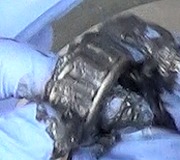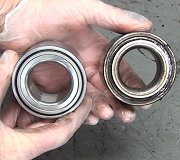Wheel bearings and its effects-
Wheel bearings perform two very important jobs in a vehicle's suspension. They allow the wheels to rotate with minimal friction, and they support the vehicle's weight. To do both jobs, the bearings must be in near-perfect condition. The seals must also be leak-free, too, to keep the lubricant inside the bearings and contaminants out.
In a typical 3,400-lb. Sedan, each pair of front-wheel bearings, as well as the rear-wheel or axle bearings, support 850 pounds depending on the front-to-rear weight distribution of the car. If we're talking a big 6,000-lb. SUV, each bearing carries about 1,500 pounds. It's a lot of weight to support for tens of thousands of miles.
Though most wheel bearings are engineered to last 150,000 miles or more, the constant load takes a toll on the bearings, the grease and the seals. A wheel bearing may fail prematurely as a result of misadjustment (in the case of serviceable bearings), contamination or loss of grease. The seals are the most vulnerable part of the wheel bearing assembly, and once a seal starts to leak, the bearings are in trouble. A worn or damaged grease seal can allow grease to leak out of the bearings, and dirt and water to enter the bearing cavity. Unless somebody discovers and corrects the problem almost immediately, the bearings are doomed.
With sealed wheel bearing and hub assembly, the seals cannot be replaced separately. If a seal has failed, the entire hub assembly must be replaced. But on older vehicles that do have serviceable wheel bearings, a bad seal can be replaced with a new one to extend the life of the bearings.
Water is murder on wheel bearings because it causes rust and contaminates the grease. Most passenger car and light truck wheel bearing seals are not designed to keep out water that's exerting pressure against the seal (as is the case when the hub is submerged). Consequently, any vehicle (especially boat trailers) that has been driven through hub-deep water or caught in a flood should have its wheel bearings cleaned, inspected and repacked with fresh grease. This obviously isn't possible with sealed wheel bearing assemblies, so all you can do is check for play or noise and replace the unit if it has suffered damage.
NOISE
The first symptom of wheel bearing trouble is usually noise. A rumbling, growling, chirping or cyclic noise of any kind from the vicinity of the wheels is a good indication that trouble is brewing and immediate attention is needed. If ignored, a noisy wheel bearing may suddenly fail, sometimes with potentially deadly consequences if the vehicle loses a wheel! Maneuvering a three-wheeled vehicle at highway speeds is a feat best left to a trained stunt driver. So if a customer says he hears a funny noise coming from a wheel, the bearings should be inspected without delay.
Wheel bearing noise is usually proportional to vehicle speed, and does not change when accelerating, coasting or decelerating (which distinguishes it from differential, transmission or U-joint noise). The noise may change when turning, or become louder or even disappear at certain speeds. But it shouldn't be confused with the clicks and pops produced by a worn outer CV joint on a FWD car. A bad outer CV joint usually only makes noise when turning, not when driving straight ahead.
According to a recent Babcox Research survey, 51 percent of bad wheel bearings are identified and replaced as a result of a customer complaining about noise, 24 percent are found during a brake job, and 19 percent are discovered during an alignment.
Noisy or rough wheel bearings need to be removed, cleaned and inspected under a bright light. Look closely for hairline cracks. If the bearing rollers, balls or races are worn, pitted, cracked or feel rough when rotated as an assembly, replacement is required. Heat discoloration indicates loss of lubrication or overtightening.
The bearing hub bore should also be inspected for damage and proper bearing fit. If the bore is damaged or does not hold the race snugly, install a new hub, rotor or drum. Also, pay close attention to the condition of the front spindles. Check them for straightness, wear, damage or cracks. Any problems here would call for replacing the steering knuckle.
WHEEL BEARING PLAY
Another problem that sometimes occurs with wheel bearings is play. Too much play can allow steering wander (which may be mistaken for worn steering components or the need for an alignment).
To check a wheel bearing, grasp the tire at the 12 and 6 o'clock positions and attempt to rock the tire. As a rule, there should be zero play on most FWD cars, but up to.010 inch of play in the front bearings may be acceptable on RWD applications that have adjustable bearings. Also rotate the tire by hand. Any roughness or noise from the bearings would also tell you the bearings are worn or damaged and need to be replaced.
If one wheel bearing has failed, pay close attention to all of the other hubs on the vehicle, especially if the vehicle has a lot of miles on it. Chances are some of the other bearings may also be nearing the end of their journey.
If there's play in a sealed bearing, replacement is necessary. But if the bearings are the adjustable variety, a simple adjustment might be all that's needed. Even so, "loose" wheel bearings should not be adjusted until they have been removed, cleaned and inspected. Bearings don't loosen up under normal use. Looseness usually means the bearings are worn, the hub nut may have backed off (a broken cotter pin or retainer), or the bearings were not adjusted properly in the first place.
ABS LIGHT ON
On vehicles equipped with anti-lock brakes and sealed hub assemblies with an integral ABS sensor or tone ring, the ABS warning light will come on if a wheel-speed sensor is reading erratically or the signal is lost. The ABS system will set a fault code that corresponds to the sensor location (left front, right front, right rear or left rear) and disable the ABS system until the fault is fixed. On these vehicles, the only way to get the ABS light to go out is to replace the hub assembly (unless the problem is outside the unit, a wiring fault or loose connector).
There is no way to disassemble and repair a sealed hub assembly. If the internal ABS sensor has failed, or if the external ABS tone ring on the hub is damaged or badly corroded, the whole unit must be replaced.
WHEEL BEARING PREVENTIVE MAINTENANCE & SERVICE
Wheel bearings that are not factory sealed require periodic maintenance. But many are neglected and never receive any maintenance whatsoever, except maybe when the brakes are relined. Even so, the adjustable variety should be cleaned, inspected and greased about every 30,000 miles or according to the vehicle manufacturer recommendations.
In the case of trailer wheel bearings, even more frequent maintenance is required if the bearings have been in water. With a boat trailer, annual cleaning, inspection and regreasing is highly recommended (usually at the end of the season).
When wheel bearings are serviced, the old grease should first be removed and the bearings cleaned and inspected before being repacked with fresh grease. This will remove any contaminants from the hub that may cause problems later on, and eliminate any risk of incompatibility between the old and new grease.
Bearings must be dry before they're repacked with grease. Also, they should not be spin dried with an air gun because doing so may damage them. A lint-free paper towel should be used to dry the bearings as cotton rags can leave behind fibers that may cause trouble later on.
Use a quality, high temperature wheel bearing grease (a #2 NLGI lithium-based grease, for example) or a synthetic wheel-bearing grease. When the grease is added, about three heaping tablespoonfuls is usually enough for most passenger car and light truck hubs. To allow room for expansion, the hub should not be packed solid with grease.
BEARING INSTALLATION
When serviceable wheel bearings are replaced or repacked with grease, always use new grease seals. Prying out the old seals usually bends and distorts them, even if they are brand new. Since this may cause leaks, you don't want to reuse them.
Bearing adjustment is very important! Overtightening adjustable tapered roller bearings is a common error that can lead to premature failure. Tapered roller bearings on the front of RWD vehicles are never preloaded. They are snugged up with no more than 15 to 20 ft. Lbs. Of torque while rotating the wheel to make sure the bearings are seated. Then the adjustment nut is loosened 1/6 to 1/4 turn, and locked in place with a new cotter pin. As a rule, end play should be about.001 to.005 inches. Always use whatever adjustment procedure the vehicle manufacturer recommends.
On FWD cars with adjustable tapered roller rear wheel bearings, the bearing adjustment procedure is usually the same as with RWD vehicles (zero preload), but some do require a slight preload. Ford, for example, says the rear wheel bearings on a Taurus should be lightly preloaded to 24 to 28 in. Lbs. (2 ft. Lbs.).
A new cotter pin should be used to lock the hub nut in place. If the hub nut is a locking nut with no cotter pin, recommend a new nut.
Tuesday, April 15th, 2008 AT 6:17 AM



